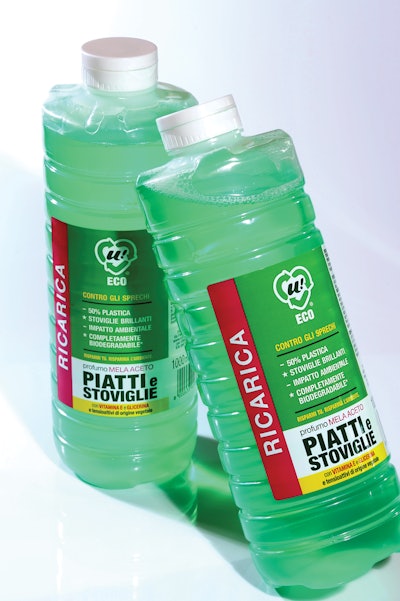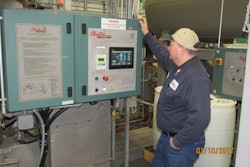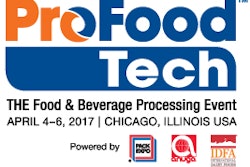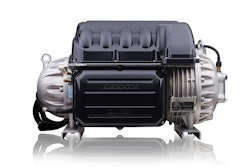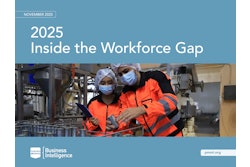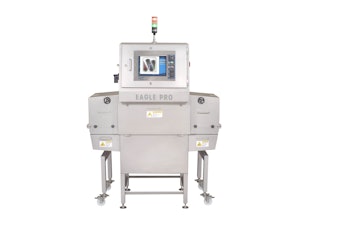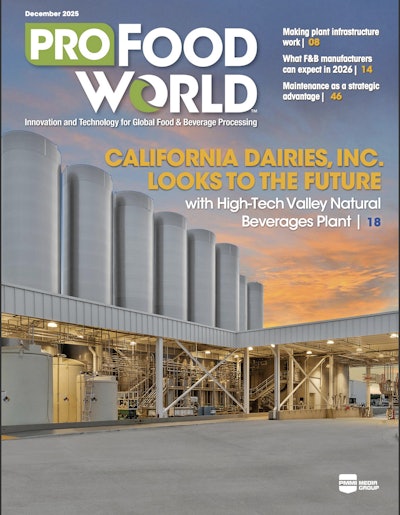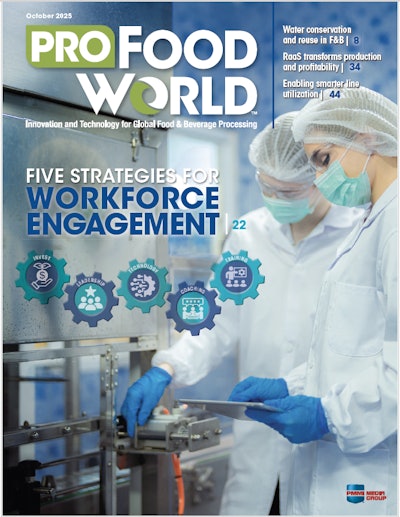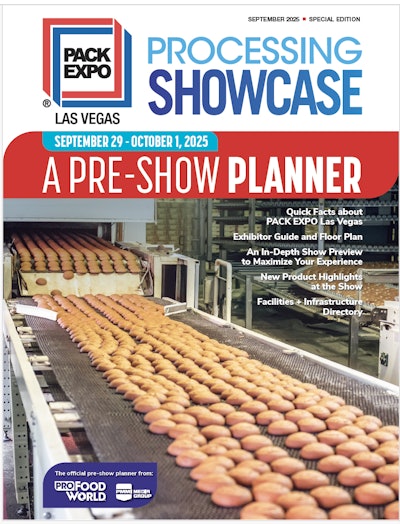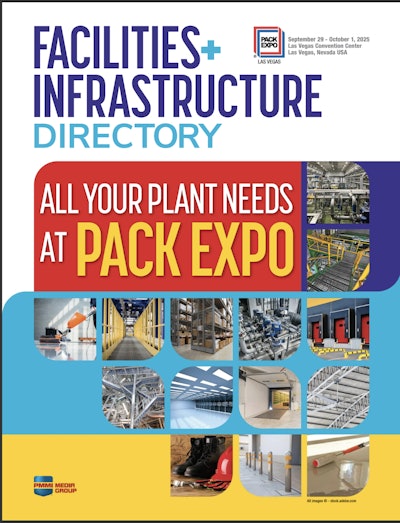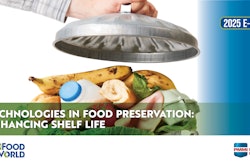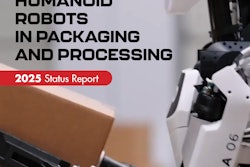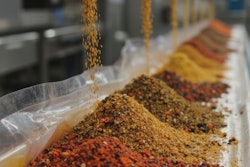Sponsored by Plastic Technologies Inc. and SBA-CCI, The Packaging Conference 2017 delivered as it usually does where new technology is concerned. Perhaps the most impressive presentation was an update by Sonoco on its TruVue multilayered retortable plastic can. Unlike last year’s sneak preview on the same topic, this year’s presentation included a commercial application by McCall Farms. Be sure to see our cover story on page 66 for a full account.
Another presentation that included a commercial application was the one delivered by Market Development Manager Ted Harris of Total Petrochemicals and Refining USA, Inc. Harris began by describing to conference attendees a proof of concept involving the use of High-Density Polyethylene (HDPE) in two-stage Injection Stretch Blow Molding (ISBM).
HDPE, of course, is widely used for containers in dairy, liquid foods, and household chemical applications, where it’s known for its chemical resistance and moisture barrier properties. Also, it’s suitable for steam sterilization and aseptic filling, it has a well-established recovery and recycling infrastructure, and availability is very good.
Processing of HDPE, however, is almost always done on Extrusion Blow Molding (EBM) systems, and ISBM has some distinct advantages over EBM, most notably increased stiffness due to biaxial orientation. Additionally, bottle-to-bottle weight consistency and gloss are better with ISBM, while opportunities for molding details are improved.
All of which prompted Total’s European research and development team to explore the use of HDPE in ISBM, a bottle-making method historically dominated by PET, a resin costing considerably more than HDPE. Like any discussion that compares the advantages of using one resin over another, price is a factor. But Total’s Harris emphasizes that it’s only one factor.
“I think what it comes down to is if maximum clarity is a priority, you go with PET regardless.If clarity is not a key performance attribute, then price is more likely to play a bigger role in choosing between PET and HDPE. Also important is that if a specific barrier or improved chemical resistance is needed, then the choice becomes HDPE regardless of price. The other things to consider are conversion throughput rates, the need to dry the resin or not, energy inputs, etc. A lot of things must be factored in when considering one resin over another. Total cost of ownership is one of those things, as is picking the resin that best fits the performance demands.”
But the relative merits of using PET vs HDPE in ISBM was not the topic of discussion at The Packaging Conference. It was the use of HDPE in ISBM compared to its use in EBM that Harris came to compare, and the benefits of using HDPE in ISBM he identified include these:
• More than a 20% weight savings
• Improved transparency and gloss
• Lower energy costs
• Potentially greater throughput
• It’s a means of meeting brand owners’ sustainability initiatives
The specific HDPE resin selected for this proof of concept was Total’s SB1359NA. Injection molding was done on a one-up Toshiba system and stretch blow molding was done on a two-cavity system from ADS. These were the key findings of a side-by-side comparison of a round 1-L EBM bottle and a round 1-L ISBM bottle that was 24% lighter:
• The EBM bottle showed more than twice as much deformation under stress than the ISBM bottle.
• In spite of being 24% lighter, the ISBM bottle exhibited the same top-load stacking strength and Water Vapor Transmission Rate (WVTR) as the EBM bottle.
Also part of Harris’s presentation was a look at the first commercial application of this use of HDPE in an ISBM approach: a 1-L refill bottle of dish washing liquid marketed by Magenta, Italy-based I.C.E. FOR SpA, Industria Chimica Ecologica. Incoplas Group makes the bottle. Interestingly enough, while the proof of concept described by Harris at The Packaging Conference included the use of two-stage reheat-and-blow technology, Incoplas is using a single-stage ISBM machine, the Model ASB-12M from Nissei. Also worth pointing out is that the Total resin used by Incoplas is not SB1359NA. “Our European SB1359 is being used,” says Harris. “They’re similar grades, but because they’re made in two different regions and have different names, they also have slightly different properties.”
Harris concluded his presentation by indicating that the use of HDPE in ISBM is indeed a viable alternative.
Bio-Succinic Acid
Purified Isophthalic Acid (IPA) is a petrochemical commonly used as an additive in PET resins to reduce the rate of crystallization, thereby improving processing and transparency without having a negative impact on final crystallinity or other performance characteristics of a finished PET bottle. Montreal-based BioAmber Inc. has been exploring the use of bio-succinic acid (BIO-SA™) as a drop-in replacement for IPA that would have the following advantages:
• Because it’s sourced from corn, it increases renewable content, lowers carbon footprint, and offers lower price volatility than a petrochemical like ISA.
• It increases productivity through faster processing times and lower processing temperatures.
• BioAmber’s study shows you can use approximately 30% less than IPA in carbonated soft drink bottles.
So what is BIO-SA? As BioAmber’s Chris Ellen, VP Sales, explained to attendees at The Packaging Conference, it’s made from renewable feedstocks such as corn (see Figure 1). The firm’s production facility in Sarnia, Canada, has a capacity of 30,000 metric tons.
Ellen described the results of a proof of concept evaluation conducted in cooperation with PolyTech Resources, which prepared PET resin incorporating BIO-SA and a control using IPA, and Plastic Technologies Inc., which handled the injection molding of preforms and the stretch blow molding of those preforms. Three co-monomer concentration variants were compared:
• 2.8 mol% BIO-SA or 1.72% weight
• 1.4 mol% BIO-SA and 1.4 mol% IPA
• 2.8 mol% IPA or 2.42% weight
Four key characteristics of the evaluation are summarized here:
• Melt Polymerization—Identical rates of esterification and polycondensation were observed.
• Solid State Polymerization (SSP)—There was no significant difference among the three variants nor was there any sticking of pellets or BIO-SA in the overhead.
• Bottle Fabrication—There was no significant difference among the three variants.
• Bottle Properties—Equivalent results were observed, though thermal stability needs some correction.
BioAmber is now engaging with pet resin producers and downstream stakeholders in the global supply chain. Brand owners, who are in a position to pull this new material into use, are showing keen interest. Resin producers, of course, are highly optimized for using IPA, so bringing in this new monomer, which is competitively priced compared to the petrochemical IPA currently used, will be no slam dunk. But interest is growing, says Ellen.
FibreForm options
On hand from Billerudkorsnas USA was Gary Robinson, Director of Business Development—Formable Papers North and South America, who outlined recent progress in FibreForm. This renewable, cold-formable customized 3D packaging solution is a natural FSC-certified paper with patented 3D cold-forming capabilities up to 10 times deeper than traditional papers. Cups, pouches, and press-formed trays are among the options that brand owners can explore.
Where cups are concerned, an ordinary paper cup is the base, and then the FiberForm is adhesive-applied to the exterior for a 3D effect. Printing of the FiberForm material comes first and is followed by die-cutting, and in the same step as die-cutting the 3D effect is imparted. Also, a thermal barrier is created by the mechanics of the 3D forming. “Because we can form so deep,” says Robinson, “you can actually create an air pocket that traps air and allows your fingers to be elevated above the hot surface of the core cup.”
Pouches made of FibreForm are quite new for Billerudkorsnas, but again they bring the element of “haptics”—any form of interaction involving touch—into play. Once again the FibreForm material, this time supplied in a roll-fed lamination and possibly having a compostable coating such as PLA, would go through a pouch-making machine (from Modern Manufacturing, Totani or KHS); thanks to special tooling the 3D effect would be applied to the substrate in registration with the graphics as the pouch is being made. “The custom FibreForm laminations produce a pouch that can be fully compostable or made with high-barrier properties,” says Robinson.
As for press-forming, which Robinson calls an “emerging technology for 2017,” it’s a new approach to the technology that’s been used to make things like paper plates for many years. But the BillerudKorsnas technology produces a smooth-walled container that is much more attractive. And again, its 3D quality gives it that all important element of haptics. Robinson says this press-forming approach has a number of advantages over molded pulp, including economics, aesthetics, and supply chain efficiency. Interest on the part of foodservice accounts is high, but also showing interest are food marketers, electronics, hard goods, and others, says Robinson.
“All of these FibreForm offerings—cups, pouches, press-formed trays—help people get out of plastics, and more than ever that is what we’re hearing people say they want to do,” says Robinson.
RecycleReady
A conference presentation by Dow’s Lamy Chopin, PhD and Global Development Leader Packaging & Specialty Plastics, described progress made by Dow in its RecycleReady initiative, the goal of which is to develop technology for store drop-off recycling of food packaging.
Much of what he talked about related to standup pouches in particular. The typical standup pouch for food products has been a multilayer adhesive lamination that includes polyester (for stiffness, printability, and some measure of gas barrier) and polyethylene (for sealability and toughness). But when these two materials are combined, that package becomes fundamentally unsuitable for recycling. In recent years, the demand for flexible packaging that is more recyclable has caused Dow and others to look at alternatives, including removing the polyester and replacing it with High-Density Polyethylene while modifying the sealant to minimize its seal initiation temperature.
One of the drawbacks to this approach is that by replacing polyester with HDPE, the gas barrier properties are compromised. So Dow looked at ways of incorporating EVOH for gas barrier purposes. Recognizing that EVOH is about as unsuitable for the recycle stream as polyester, Dow developed a compatibilizer called Retain™ that allows the EVOH to be fully dispersed into the polyethylene instead of remaining in chunks that cause bad optics and poor physical properties.
Another drawback to replacing polyester with HDPE is that throughput on the pouch-making machines tended to dip. Dow addressed this problem by developing Opulux HGT™, a coating that, when applied to the film, permits pouch making to go from a maximum of 150 pouches/min to 250. As Chopin puts it, “it brings full operating speed and full compatibility with the recycle stream.”
Among the most recent development coming out of the RecycleReady initiative is Innate™, a PE technology that brings enhanced stiffness and toughness to a standup pouch that has no polyester in it. As Chopin described this and other Dow developments, he emphasized how important a role is played by consumer education, specifically the How2Recycle label program started by the Sustainable Packaging Coalition. “Programs like this,” he says “bring consumers an important message: Flexible film when it’s recycled has value, and science backs it up.”
RecycleReady, says Chopin, “has been a matter of chipping away at the performance compromises you run into once you take polyester out of a standup pouch in order to make it recyclable,” says Chopin. “It included us going out and validating that it really works in the recycle stream by doing field scale testing with partners who are recyclers.
“RecycleReady is an ongoing development platform of innovations all aimed at delivering pouch packaging that can be recycled for as many applications as possible. It addresses a specific market need around being able to show consumers that flexible packaging is recyclable. But that’s not the end of the game. Our holistic approach to product stewardship tells us that even the nonrecyclable stuff needs to go somewhere other than in a landfill. And that’s where pyrolysis comes in. Dow is not directly involved in doing pyrolysis, but our goal is to use our industry leadership to help establish appropriate collection and aggregation of the plastics so that they can be efficiently taken to a pyrolysis operation.”
Pyrolysis is a process of depolymerization—taking a polymer built out of small molecules and returning it to those small molecules so they can be used in the production of fuels and petrochemicals. The polymer is heated in the absence of oxygen to a high temperature but, because there’s no oxygen, the polymer doesn’t burn. Ultimately the bonds of the polymer are broken so that it returns to its base molecules.
“There are two or three firms with serious plans for pyrolysis, but the one I happen to know best is RES Polyflow,” says Chopin. “They just conducted a capital campaign for a midwest facility, and now they are ready to start putting steel in the ground and scale up to where I actually think all of the Midwestern region will be able to supply plastic to them. It’s chemical recycling as opposed to mechanical recycling. But the key to both, the key to all recycling, is getting a continuous flow on a large scale into your system.”
A Phase 1 pilot program in Citrus Heights, CA, in July 2014 demonstrated that getting that continuous flow into a pyrolysis processor is doable, says Chopin. And this past September, in Omaha, NE, 6,000 members of Recycle Bank were able to collect previously non-recycled plastics—chip bags, candy bar wraps, drink pouches—and instead of putting these items in a landfill they were able to put them into Hefty Energy Bags and toss them into their regular recycling bins. From there they made their way to Systech Environmental Corp. where the bags and all their contents are converted into energy to make cement.
PETN copolymers
Director of New Business Development Frank Embs of Indorama Ventures, a Bangkok-based global leader in the production of PET and polyester fiber, delivered a presentation on the opportunities that might exist in using PET/PEN copolymers for packaging.
A decade or so ago there was a lot of excitement over the possibility of blending PEN (polyethylene naphthalate) in PET for packaging applications as a way of improving gas barrier, water vapor transmission rates, and dimensional stability in microwavable trays or hot-filled bottles. Amoco in particular pushed these applications of PEN. But the cost picture never got to where it needed to be and, at the same time, blending the two polymers together created certain practical challenges in processability.
But lately Indorama has been looking into the use of four grades of PETN, a PET/PEN copolymer as opposed to a blend, that have the potential to address unmet market needs. Embs described them, all marketed under Indorama’s PolyClear® Preserve PET banner, as follows:
• 2222—a low-modification PETN showing higher heat deflection and better dimensional stability as well as improved resistance to cleaning chemicals
• 2224—a medium-modification PETN suitable for aggressive cosmetics products or for consumer bottles needing to be safe in the dishwasher at temperatures up to 85 deg C
• 2226—a high-modification PETN suitable for containers needing to withstand temperatures to 65 deg C and 8 bar pressure; possible applications might be in cosmetics and industrial spray cans for aggressive chemicals
While the above grades are all for ISBM, a P024 grade described by Embs is a medium-modification PETN that has a higher melt strength and is designed for extrusion blow molded bottles that can be hot-filled beyond 80 deg C. Think EBM handled bottles for ready-to-drink teas, for example.
Indorama isn’t suggesting that there will be wholesale shifts from PET to PETN, but Embs does see opportunities for PETN in a number of niche applications, especially in the EBM market. He indicates that applications are being explored worldwide.
